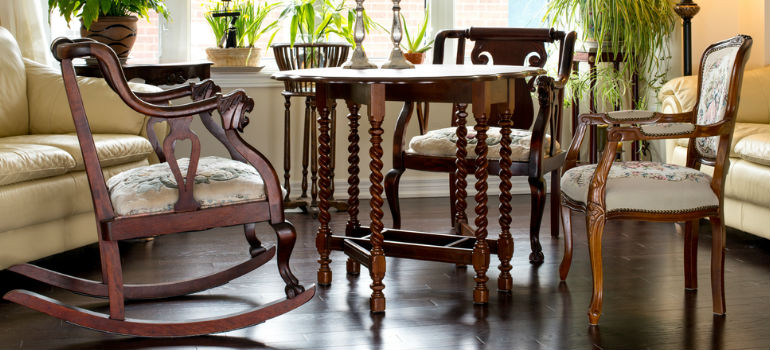
We’ve all sat on, or owned, a wooden chair that refuses to be like the others. Instead of providing a stable place to sit on, this chair wobbles more than a trifle during an earthquake and has you constantly warning guests to be careful while sitting on the demon chair.
Wobbly chairs may only be a small inconvenience, but the frustration caused by the wobble will slowly eat away at your patience and sanity. Rather than following the urge to smash the chair and throw its mangled remains in the trash, follow our step by step guide to repair all of the wobbly chairs in your life.
Table of Contents
Need a Handyman?
Enter your postcode to view our rates and availability in your area.
For questions about the services we offer visit our main site or you can always call us at 020 3404 4045
Reasons the chair is wobbly
Before beginning the repair process, you may be wondering why your chair is wobbly in the first place. There are a few causes for this wobbly chair syndrome and we will outline them below.
- General usage – most chairs are quite lightweight, usually no more than a few kilograms, but the weight they carry each day is many times larger. A person’s body weight is not a static weight, either. We move, twist, and turn to search for that comfortable spot or to reach for something on a table. As we move around, our weight adds stress to the various joints. This weakens them and causes the joints to become loose. The looser the joints become, the wobblier the chair gets.
- Age – time wreaks havoc on all things. Whether it is a person or an inanimate object, nothing escapes the ravages of time. As wooden chairs age, the wood shrinks which this leads to the joints weakening, becoming loose due to the wood shrinking, or just breaking.
- Poor craftsmanship – poorly made furniture has a much greater chance of breaking than quality pieces. This is as true for chairs as it is for any other piece. Wooden chairs, which have been either poorly built or constructed of substandard materials, will turn into a wobbly rocking chair faster than you can ask “Why is my chair wobbly?”.
- Ineffective repair – when most people decide to repair a wobbly chair, the only thing they reach out for is some glue. This may resolve the wobbly chair issue for a while, but it is only a short-term solution.
Materials and Tools You Need
- A wobbly chair;
- A hammer, rubber mallet, or a dead blow hammer;
- A rope or a strap with a ratchet clamp;
- Electric screwdriver;
- A drill;
- Drill bits;
- Wood glue;
- Pencil or marker pen;
- Masking tape;
- Sanding paper or a scraper;
- A rag;
- Small paintbrush;
- Screws or small nails.
How to repair a wobbly chair
Now that you know why your chair is wobbly and what you will need to start the repairs, it is time to move on to the fun part, the actual repairs.
- Label each of the parts of the chair – using a simple numbering or lettering system, label each piece of the chair before taking it apart. Not only will this help during the repair process, it will also help when it is time to put the chair back together.
- Carefully take the chair apart – look for small screw holes near the joints and corner blocks of the chair and remove any screws with the electric screwdriver. Following this, take the joints apart by gently tapping them with a hammer or a rubber mallet. If there is glue in the joints, you may need to use more force, but don’t use so much that you cause even more damage to the chair.
- Clean the old joints – remove any old glue from all of the joints with sanding paper, including the pins and inside the mortise holes. Wood glue works best when it is applied to bare wood, so try to remove as much of the old glue as possible. If you skip this part, you will find your chair wobbling again soon after.
- Apply the new glue – coat the mortise holes on the inside with wood glue using the small paintbrush and then apply glue to the pins. Don’t worry about using too much glue. Put the chair back together while gluing one section at a time.
- Tie the chair up – wrap the rope or strap it around the newly glued sections and tighten it to hold the joints in place while the glue dries. Wipe away any excess glue with the rag and repeat this process for each section of the chair you put back together.
- Let the glue dry – allow around 24 hours for the glue to completely dry before using the chair.
Check also:
[Download] Home Maintenance Checklist
If you think that your chair needs more support than glue can provide, you can follow the optional repair steps below. Just be sure to do this before the glue dries.
- Drill a small hole where each joint connects (i.e. through the legs and into the stretchers).
- Drive screws into each hole with the electric screwdriver.
- If you are using small nails, pour some glue into the drilled hole before hammering the nails in.
- Wipe away any excess glue.
- Wait for the glue to dry.
So there we have it, your guide to repairing a wobbly chair. With a little bit of planning, wood glue, a hammer, some rope, and this guide, you will never have to suffer from a wobbly chair again. Go forth and amaze your friends and family with your repair skills, astound your love interest with your DIY know-how, and bask in the glory of your new knowledge!
Image Source: Donald Z /shutterstock.com




Amazing!It’s really a very nice step by step guide. I always used to think that repairing furniture is a very complex job but now it seems to be simple and fun.Now I feel there is nothing to worry even if I can’t find a plumber as I know how to fix it myself:)